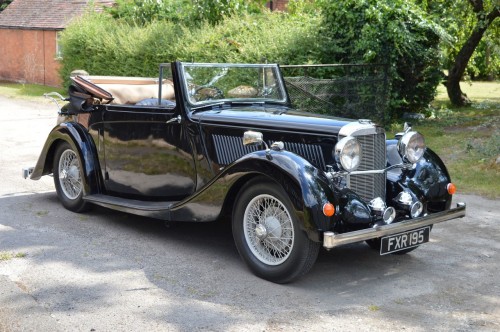
Click Here for Full Screen Image - Click Here to Download Image
 |  |  |  |  | |||||
 |  |  |  |  | |||||
 |  |  |  |  | |||||
 |  |  |  |  | |||||
 |  |  |
| Lot number | 175 |
|---|---|
| Hammer value | £26,500 |
| Description | Alvis 12/70 Mulliner DHC |
| Registration | FXR 195 |
| Year | 1939 |
| Colour | Black |
| Engine size | 1,842 cc |
| Chassis No. | 15489 |
| Engine No. | 15977 |
| Documents | V5; two buff logbooks; MOT May 2016; file of invoices |
Alvis cars have always had something special about them. The firm’s ability to produce a car far greater than the sum of its parts started with the immortal 12/50 and carried through to their final model, the fast and elegant TF21, the last of which left the Coventry factory in 1967.
Their engineering integrity, powerful and reliable engines, low chassis stance and excellent choice of coachbuilders were all critical factors in building their reputation for making sporting grand tourers.
The superb 12/50 was tweaked into the 12/60, which in turn was facelifted into the Firefly with its synchromesh gearbox. A much needed increase in engine capacity to 1,842cc increased output to 62.5bhp in the subsequent Firebird model which kept performance up to scratch, despite ever heavier coachwork taking its toll on the traditional sprightly Alvis performance. By September 1937, George Lanchester had significantly reworked the whole car, the resultant 12/70 model becoming one of Alvis’ most successful models, 776 finding buyers before war broke out.
Good for 80mph and up to 26mpg in normal use, it continued in production in 1946 as the 14hp, a model which served the company well with nearly 3,450 leaving the factory before they focussed on larger engined models after 1951.
Most 12/70s were bodied at Mulliners and this fine looking DHC is no exception. Purchased by the vendor in 1988 as a part restored project, he finally completed the restoration around 12 months ago. When purchased, the engine had been professionally overhauled, the task in hand being to reassemble the car, locating various hard to find small parts along the way. It was professionally rewired by Vehicle Wiring Services and the interior retrimmed in leather. The distributor was sent off to the Distributor Doctor for rebuild, since when the car has reputedly "run like clockwork".
The Alvis works record describes the car as a ‘four cylinder drop coupe’. The completed chassis was sent to Mulliners in Birmingham for coachwork, the car being originally painted in Dark Crimson Lake with a grey hood and trimmed in standard red leather. It was dispatched to King’s Court Garage, London W6, on 30th May 1939 and delivered to first owner, Lord Rhidian Crichton-Stuart of Eaton Square SW1 (he being a son of John Crichton-Stuart, 4th Marquess of Bute). The two buff log books show the trail of ownership since.
During our visit to catalogue the car we were treated to an extended test drive, the car performing very nicely, showing an easy cruising gait of 50mph+. The synchromesh gearbox makes it an easy car to live with, the lively engine allowing this comfortable and elegant drop head to keep up with modern traffic with ease.
On the button and ready for immediate use, this rare and attractive pre-war coachbuilt Alvis ticks all the boxes, especially as the model is so well supported by a thriving owners' club and several marque specialists.